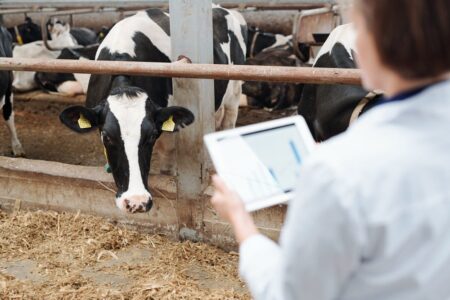The heat wave that rolled through the Corn Belt and pummeled the United States from Nebraska to the Eastern Seaboard over the last week was unique due to the early onset of summer temperatures and the amount of precipitation it produced, according to an AccuWeather meteorologist.
Temperatures in much of the top corn and soybean producing states soared into the upper 90s, and in Mitchell, South Dakota, the temperature reached a record 104 degrees on June 21. The wave shifted toward the eastern portion of the Corn Belt and the East Coast at the beginning of the week. The National Weather Service put parts of Ohio, Pennsylvania, and Indiana at “extreme” heat risk as of June 25 — a measure of the health risk of high temperatures to people without effective cooling or hydration.
What is the impact on crops in the top corn and soybean growing states, and what’s ahead?
‘Surprising’ Rainfall Could Mitigate Impact of High Temps
Iowa Environmental Mesonet
AccuWeather Senior Meteorologist and Long-Range Forecast Leader Paul Pastelok said the amount of rainfall during the heat wave was “surprising” and not common with sustained high temperatures.
“What’s more surprising about this is that look how much rainfall there was,” Pastelok said. “Not so much in western Iowa and eastern Nebraska as anywhere from the Upper Midwest to Tennessee, Ohio, the Mississippi Valley and to the northeast, central Appalachia. There’s been a lot of rainfall, a lot of moisture in the ground, and a lot of vegetation growth. A lot of times you don’t tend to see a heat wave of this magnitude to occur at this time of the year. Usually it’s late July you see these kinds of temperatures, but because of all that moisture generally holds back temperatures from being exceptionally hot. It went all against that.”
Pastolek said coming days could see storms in the region— a “split” of the system could create air cooling high in the atmosphere while temperatures on the ground are still high — that lead to unstable conditions. Pastolek said storms with the potential to damage crops are possible but added likely would not produce tornadic activity.
June has been a wet month for most of the Corn Belt, according to data from the Iowa Environmental Mesonet. North and South Dakota have been relatively dry, with the Mesonet showing the region hovering between 1-3 inches of precipitation below the historical average.
Oklahoma, Kansas, and Missouri have been especially hard-hit by rain compared with historical averages. In the southeastern corner of Kansas and northeastern portion of Oklahoma, precipitation has fallen at a rate of 7 to 8 inches above historical averages for June thus far. Other parts of the Corn Belt getting soaked include western Kentucky and Tennessee, which are hovering around 5 to 6.5 inches above average in precipitation.
Pastolek said western Iowa and eastern Nebraska were running behind, sitting at “around 50-60% of normal rainfall” to this point in the growing season.
What a ‘Wet-Dry Pattern’ Would Mean
AccuWeather
As a wet June comes to a close, Pastolek said the short-term forecast calls for more heat around the July 4th holiday before a return to a “wet-dry pattern” as summer kicks into gear.
“The humidity will come up, it’ll feel pretty hot once again, but it won’t be the same structure as what is going on or what just happened. In this area, it’s just your typical front that heats up and then breaks down and backs off again. I think we will go into that kind of pattern again.”
The reason for a more traditional summer pattern? Pastolek credits the split of a high pressure “heat dome” in the coming weeks.
“What’s going to happen now is the high pressure area, this big dome, will split,” Pastolek said. “One area is going to go over and form south of Bermuda off the southeast coast. The other one is going to situate more off the central and Northern Rockies. It’s going to keep building during the month of July, and disturbances are going to go over top of that, down through Alberta and Saskatchewan through to the Dakotas, and do a split.
“Some of the moisture may go straight south toward Texas and Oklahoma. Others may cut across the crop areas, Missouri, Iowa, and Illinois, then head toward the Ohio Valley. We’re going to be in a pattern that we saw in the spring a little bit.”
Nighttime temperatures, which have remained high in recent weeks, could also regulate as part of this pattern returning, Pastolek said, which would be a boost for farmers. High nighttime temperatures can cause damage to crops and impact yields over a sustained period in the growing season.
AccuWeather forecast maps for July and August predict the Plains to receive above-average temperatures and below-average precipitation in July, with the Dakotas predicted to also get below-average precipitation in August.
On the other end of the spectrum, the Eastern Corn Belt (Ohio, Kentucky, Tennessee, and Pennsylvania, in particular) is predicted to have at least 125% of the normal rainfall in July through September, potentially setting up for a wet run-in to harvest season.
Areas of Pennsylvania Late on Planting
AccuWeather
Pennsylvania’s corn emergence currently sits at 84% in the latest USDA Crop Progress Report, which is 6 percentage points behind the state’s five-year average. Pastolek, who is based in the state, said some local fields have been flooded by rainfall during planting season — causing delays with planting and forcing some to re-plant corn and soybeans.
“Some fields are still soft,” Pastelok said. “They’re still hurting right now.
“I think in Pennsylvania, there’s enough moisture in the ground to compensate and get away with the heat that we just went through. I don’t think that’s a problem temperature-wise. The other problem is a lot of people planted late or maybe even gave up a little bit in their planting of corn this year because they couldn’t get the machinery out there to start working on some of those fields.”
Pastolek said weather patterns for the rest of the summer in the area could still lead to positive results in the fields, although he cautioned that the wet weather could lead to more disease worries.


:max_bytes(150000):strip_icc()/100363261_barn_machine_sheds-63093df342b84ee89105b03a77a2186b.jpg)
:max_bytes(150000):strip_icc()/For-Sale-Farmland-Natalina-Sents-Bausch-d53037fe10b24b288740b5a3089aa5c7.jpg)



:max_bytes(150000):strip_icc()/42148500861_b399b29f0c_k-2000-26082808d8964f7bbcc54a564c12afb6.jpg)

:max_bytes(150000):strip_icc()/ThomasBarwick-1342991835-073cc392f4cd4d1abc524fc3c1360b50.jpeg)

:max_bytes(150000):strip_icc()/54423888214_35f42f008a_o-fa43d222309f4ac49e57f8d4bcfbf18f.jpeg)